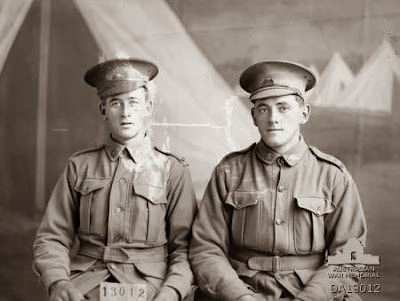Photo taken about 1916.
Portrait of Sister May Dickson, Queen Alexandra's Imperial Military Nursing
Service (QAIMNS), the first Australian woman to be buried in Australia with
full military honours.
Image courtesy AWM. Image P05159.001.
Sister May Dickson’s final resting place is
Coburg Cemetery and this is her only connection to the area. Although an
Australian, she headed for England soon after war was declared and joined Queen Alexandra's Imperial Military
Nursing Service (QAIMNS) and so is not listed amongst the records of the
Australian nurses who served. She remained in England until her health failed
her, returning to Australia in the hope that our milder climate would restore
her health. She had almost reached her home city of Sydney, but became so ill
that she was taken off the ship in Melbourne where she died on 4 October 1917.
She was buried with full military honours, the first Australian woman to be
accorded this honour.
His Majesty, King George V,
decorating two Australian Nursing Sisters with the Royal Red Cross at an
investiture held at Buckingham Palace, 3 May 1919.
Image courtesy AWM. Image
D00597.
Royal Red Cross, 1st
class.
Image courtesy AWM.
Image REL29121.
Sister Elizabeth Regan died at her home in
Camberwell in July 1945 aged 60 and was buried at Coburg Cemetery. This is her
only connection to Coburg. Born in Carlton in 1884, she trained at the
Launceston General Hospital and then worked at the Royal South Sydney Hospital.
She served as an army nurse in the 1st World War, enlisting in
August 1915 aged 30. Her next-of-kin, her mother, lived in Abbotsford. Sister
Regan and proved to be an outstanding war nurse. She was Mentioned in
Despatches for her ‘distinguished and gallant service and devotion to duty’ in
1917 and was awarded the Royal Red Cross, 2nd Class in July 1919,
which was conferred on her by King George V at Buckingham Palace. On her return to Australia, Sister Regan
established a private hospital in the Melbourne suburb of Oakleigh. She then
took up the position of Matron of Guildford Boys Grammar in Western Australia
and only returned to Victoria a few months before her death. (Sources include
her attestation papers; The Daily News,
20 July 1945; Launceston Examiner, 21
July 1945).



























